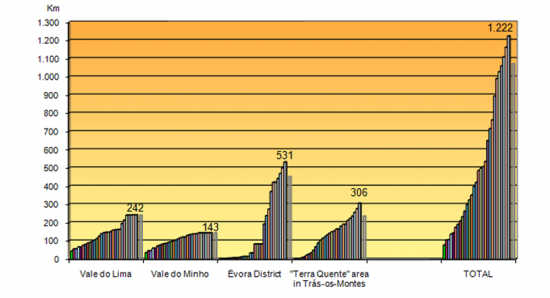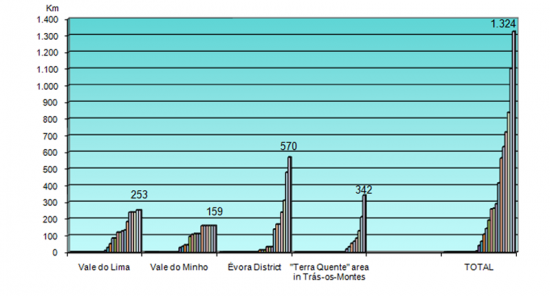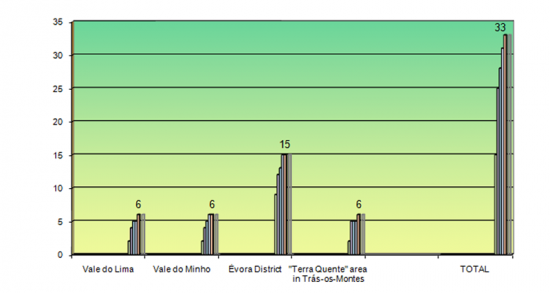

 Infrastructures and Security
Infrastructures and Security  News
News  1st NGNs in Portugal Available at the Scientific and Higher Education System and at 4 Rural Areas
1st NGNs in Portugal Available at the Scientific and Higher Education System and at 4 Rural Areas 1st NGNs in Portugal Available at the Scientific and Higher Education System and at 4 Rural Areas
- 28/12/2008 At a time when operators take the first decisive steps for Next Generation Networks (NGN) and the issues related to investment, management and business models of such networks are discussed, two types of advanced NGN promoted by public authorities with the support of the Knowledge Society Agency (UMIC) – the Broadband Community Networks for e-Inclusion, and the Science, Technology and Society Network for e-Science – are already well developed.
At a time when operators take the first decisive steps for Next Generation Networks (NGN) and the issues related to investment, management and business models of such networks are discussed, two types of advanced NGN promoted by public authorities with the support of the Knowledge Society Agency (UMIC) – the Broadband Community Networks for e-Inclusion, and the Science, Technology and Society Network for e-Science – are already well developed.
The RCTS – Science, Technology and Society Network today provides connectivity on optic fiber cable owned by the FCCN to about 55% of the public Higher Education (with institutions weighted by the number of enrolled students), a situation achieved since 2005 and which made it one of the more advanced Research and Education Networks in the European Union. In July 2008, this network was linked internationally at 10 Gbit/s, about 10 times the value of July 2005, and in 2009 it was expanded to 20 Gbit/s. A Next Generation Networks (NGN) requires, besides infrastructure, advanced services in broadband and the RCTS is exemplary in this regard, as a result of the provision of various services developed in the last few years:
- Knowledge Library Online (b-on), planned in 1999 and starting operation in 2004, through which people at scientific and higher education institutions can access full text of scientific publications, from which 5.2 million downloads were done in 2008, 2.5 times the figure of 2004 (2.1 million downloads);
- National Grid Initiative (INGRID), launched in April 2006 and boosting the number of CPU CORES of the National Grid infrastructure to arrive in early 2009 to more than 25 times what it was in May 2006, with the construction of a national Grid Computing node in a new 400 m2 datacenter at the FCCN;
- Open Access Scientific Repository of Portugal (RCAAP), developed in the second half of 2008 and released in December 2008, which has already integrated into a nationwide system 14 institutional repositories of several universities, placing Portugal at the forefront of the international movement on opne access scientific repositories, and aiming to integrate repositories of all the scientific and national Higher Education system;
- Repository of high-definition video with Creative Commons licensing and Digital Rights Management (Zappiens) (site in Portuguese), available since mid-2008;
- VoIP – Voice over IP for all public Higher Education, a service provided from early 2009 with major cost savings made possible by the elimination of external costs with telephone communications within the system and by the cost reduction with external communications resulting from aggregated procurement of communication services to all public Higher Education system;
- e-U Virtual Campus, integrating all public Higher Education institutions and the private Higher Education that wanted to join the system into a single virtual nationwide campus wireless accessible and with an integrated authentication system, which began to be installed in late 2004 and had its major expansion in the second half of 2005, and at the time was a world leader;
- Cybersecurity, supported on the CERT.PT (site in Portuguese), the first internationally accredited CSIRT – Computer Security Incidents Response Team in Portugal, and the only one between September 2002 and July 2007, when the CSIRT.FEUP of the Faculty of Engineering of University Porto started operation, followed in July 2008 by the CERT.IPN of the Laboratory of Computer Systems of Institute Pedro Nunes, associated withe the University of Coimbra;
- Services for high-definition video conferencing and video-diffusion (site in Portuguese) through the Internet.
Regarding to NGN in rural areas, at the end of 2008 the construction of the 4 Broadband Community Networks was completed: “Distrito de Évora”, “Terra Quente Transmontana”, Minho Valley, Lima Valley. This accounts for a total length of optic fibre cable exceeding 1,200 km with active equipment that allows operation at 10 Gbit/s, with a total investment of 34 million Euros. The Knowledge Society Agency (UMIC) conceived the program for the creation of Broadband Community Networks, and created and assured the operation of the Technical Assistance Commission (CAT), which coordinated activities and the monitoring of the projects implementation. The following figures show the evolution of progress indicators for the 4 projects.
Portugal gives clear signs of being prepared for the expansion of NGN. In fact, from 2005 to 2008:
- The penetration of broadband in households doubled, reaching 39%.
- The penetration of broadband in the population nearly tripled, reaching 33%.
- Internet use by students and by people with secondary or higher education is very high, respectively 97%, 87%, 91%, figures of the order of those for Scandinavian countries.
- Internet usage by people who have not completed secondary education increased by 57% and is now 26%.
Length of Technical Ducts Built within the Broadband Community Networks Projects
Kilometers (Km), weekly evolution from 20-JUN-2008 to 19-DEC-2008 and final objectives
Alternative access: 
click que image bellow to amplify
Source: Knowledge Society Agency (UMIC), based on weekly information from the promoters.
Length of Optical Fiber Cable Installed within the Broadband Community Networks Projects
Kilometers (Km), weekly evolution from 20-JUN-2008 to 19-DEC-2008 and final objectives
Alternative access: 
click que image bellow to amplify
Source: Knowledge Society Agency (UMIC), based on weekly information from the promoters.
Physical Points of Presence (PoP) Ready to operate within Broadband Community Networks Projects
No. of units, weekly evolution from 20-JUN-2008 to 02-JAN-2008 and final objectives
Alternative access: 
click que image bellow to amplify
N.B.: A Physical Point of Presence (PoP) consists in active transmission equipment, commutation, insertion,
extraction and traffic transit, interconnected with other PoPs, with capacity to serve a high number of users.
Source: Knowledge Society Agency (UMIC), based on weekly information from the promoters.



